The art of Lita Cabellut (Barcelona, 1961) is pure feeling, like the haunting voice of flamenco singer Camarón de la Isla whom she so greatly admires. The colossal format of her paintings and subjects, whom she endows with great psychological potency, are the clamor of an artist who needs her voice to be heard. Her work exudes the wisdom of life that runs through her gypsy veins. She portrays souls with expressionist strokes that spring from forces underlying all thought. Their gaze is by turns defiant, nostalgic, beseeching, proud, sensual, wise… Every portrait tells stories: the stories of the artist, our own, and universal stories of the human condition. Gaze, gesture, and skin convey the scars of life’s wounds but also all its beauty. A constant dichotomy exists in her life and work: the formal and the wild, light and dark, reason and passion, but always there is beauty.
Author: Elena Cué
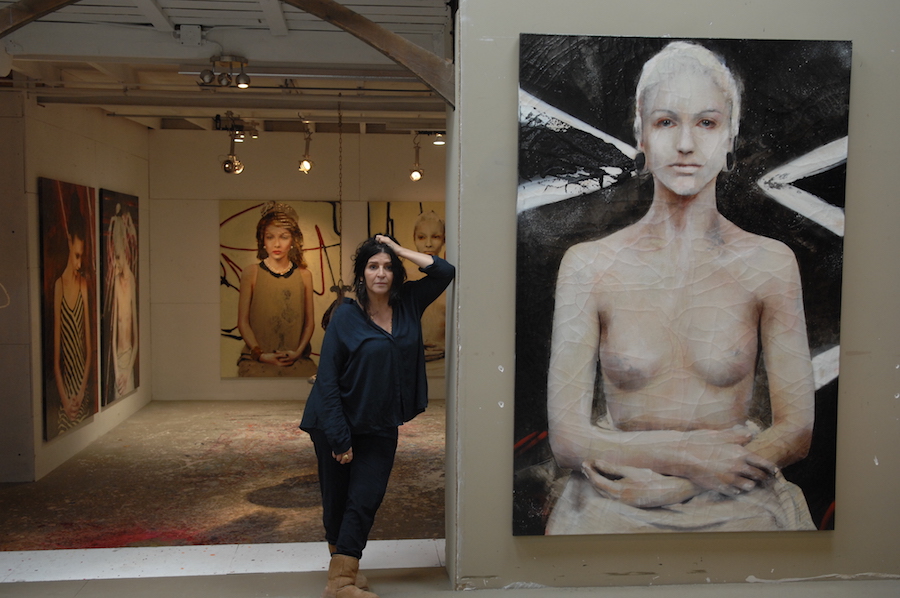
Lita Cabellut. Photo: Elena Cué
The art of Lita Cabellut (Barcelona, 1961) is pure feeling, like the haunting voice of flamenco singer Camarón de la Isla whom she so greatly admires. The colossal format of her paintings and subjects, whom she endows with great psychological potency, are the clamor of an artist who needs her voice to be heard. Her work exudes the wisdom of life that runs through her gypsy veins. She portrays souls with expressionist strokes that spring from forces underlying all thought. Their gaze is by turns defiant, nostalgic, beseeching, proud, sensual, wise… Every portrait tells stories: the stories of the artist, our own, and universal stories of the human condition. Gaze, gesture, and skin convey the scars of life’s wounds but also all its beauty. A constant dichotomy exists in her life and work: the formal and the wild, light and dark, reason and passion, but always there is beauty.
We begin our conversation in her studio and home in The Hague.
Elena Cué: You were abandoned by your mother just months after you were born, taken in by your grandmother and lived on the streets of Barcelona until you were adopted at age thirteen. You knew you wanted to be an artist at that age, when your adoptive family took you to the Museo del Prado for the first time. In your earlier life, before you began to paint, how did you channel your artist’s energy?
Lita Cabellut: Through fantasy, I think. You aren´t aware of what you are living or doing at the time. But what I do remember is that I was a ghost: I sold stars, for example. Now I think about it, and the artist was already present. Though of course, talent that isn´t developed doesn´t grow.
What do you think art is about?
It’s a way of conceiving, seeing and feeling about life. Art is much more than material. It is a great empathy for the world, for life. That is what art really is, because much of it is ethics, and fundamentalisms. It’s unavoidable: freedom and dictatorship at the same time, life and death. It’s so complicated and so simple at the same time. We always want to idealize art, isolate it, and make it individual.
Which it isn’t.
Which it isn’t, and that’s why art is suffering right now. We’re determined to isolate it and make it individualistic. Plato said that beauty was love materialized. I think that´s sort of it. Art absorbs, because it is a constant death and rebirth in the same day. You have to give it everything, and that’s why there’s a lot of risk in my work. The line between good and excellent is so fine, and that excellent has a risk. Not to be better, but to overcome what you don´t know. When we love and cherish what we don´t know, that´s when we start to understand what art is. Because art is ugliness as well, and it is beauty, and hardness. Art is velvet on the outside and bleach on the inside, because it burns you.
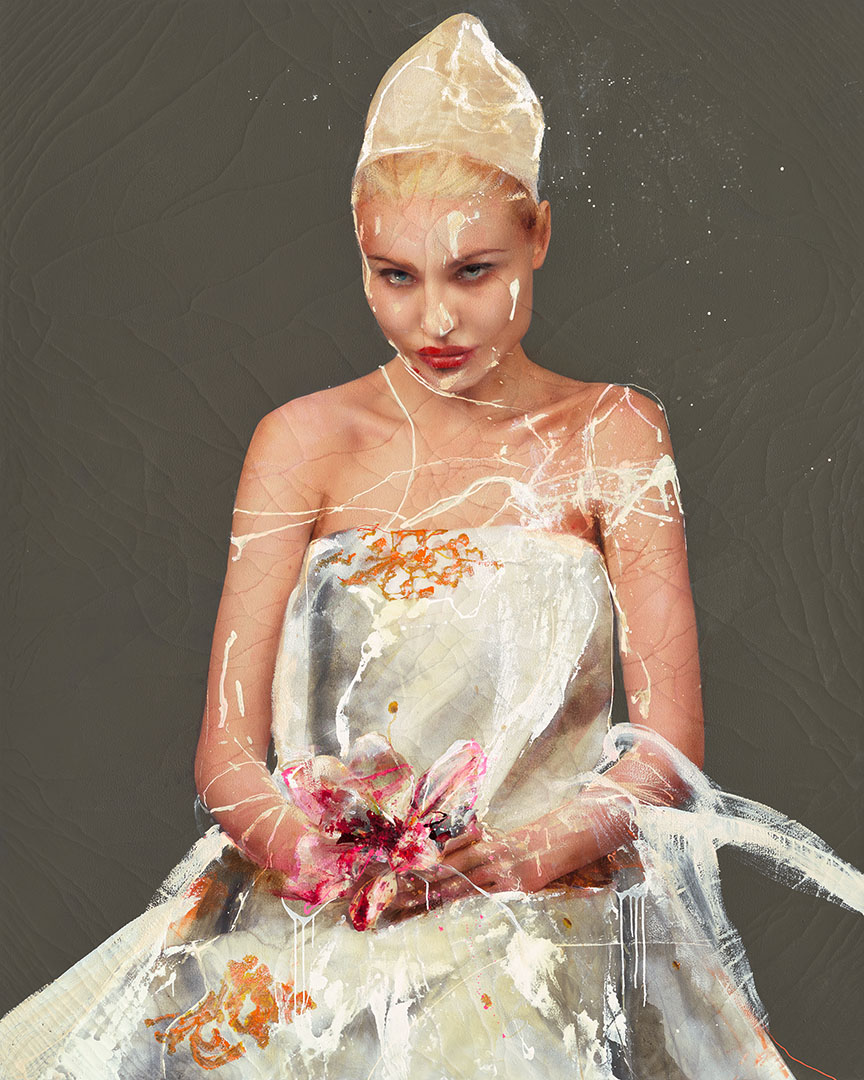
Lita cabellut. Impulse. Courtesy of the artist's studio.
Why did you choose figurative painting as a means of expression and focus on portraiture?
It´s an obsession. In reality, my great passion has always been psychology. When I was a small child I was already aware that by studying people you could prevent calamities. I knew very well what my next three hours were going to be, what the situation might or might not be. And then that turned into a form of survival, and then a way of living. What interests me most are human beings, because humans are so complex, so beautiful and ugly at the same time, so much so that it is fascinating. So I began to pay attention to figurative artists, and then I switched over completely to Saura, Tàpies and abstract artists. And you can see it in my work. It’s a communion of figuration and abstraction.
What is the importance of abstraction to you?
Abstraction is very important to me. I went back to the museums, to study Velázquez, Goya... I realized that they were the great abstract artists, and that they used it as a means for illusion to give form to a figuration that did not exist. That´s when I began to see abstraction as interesting, from that philosophical point of view. The great masters use figuration as an illusion of something that doesn´t exist and that our brain finishes. For example, if you look closely at a clothing in Velázquez, with its cuffs and fabrics, it’s totally abstraction. It´s an illusion of what you are seeing. It is points of light, of matter, placed in such a chaotic and anarchical way that from a distance they form an image that forces you to see. So if the artist has the power to manipulate the eye of the person who is seeing, and takes the eye to another place where it would not normally see, that’s art. That seemed very interesting to me, and I began to use figuration much more. At first without faces, just bodies. Because I wanted to study position for people to see gesture.
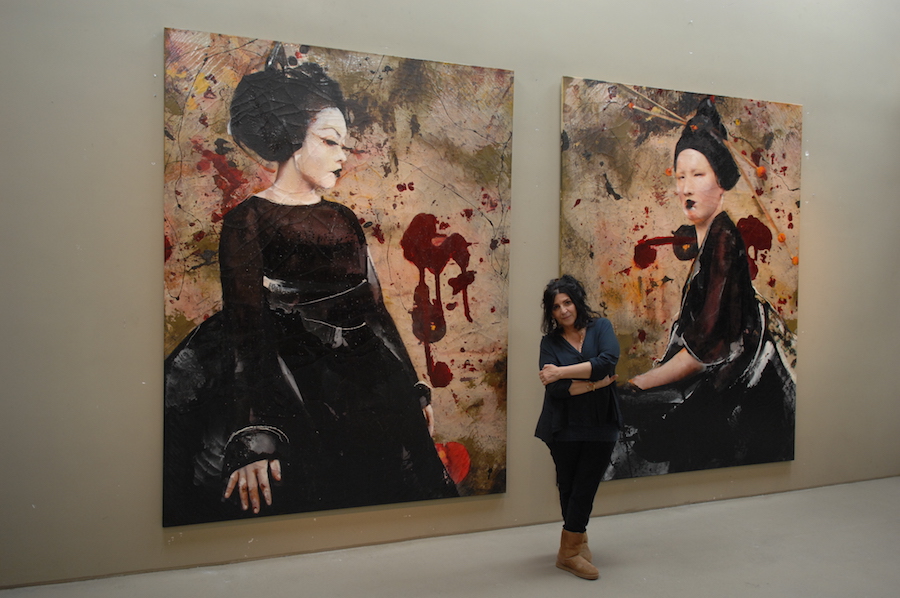
Lita Cabellut. Photo: Elena Cué
How do you choose your subjects?
They´re models. But first is the theme. I always work by themes.
And how do these themes come up?
For example, the trilogy of doubt came to me one night when I was talking with a friend who told me that she was having a legal problem. And I thought, there is so much doubt in knowing who is right, and truth is so difficult to find. And suddenly the title came to me: the trilogy of doubt. It will be about power, impotence and ignorance. Because through ignorance, tremendous things are done.
And in what way are you in each one of these portraits?
All portraits are great self-portraits. They are a way to relive distant, hidden, present and latent emotions every time. Every portrait is me. In the trilogy of doubt, where there is the great dictator, a victim and an ignorant, I’m all three. When I paint, I am in the painting. It´s me. You know what happens? You can only paint or create what you know. Empathy happens because we recognize ourselves in something. We cannot feel something we don´t know. It´s impossible, just an illusion.
Is art a cure or a palliative?
It´s difficult for me to imagine life without art. It´s as if God had turned out the lights of the world. The sadness I feel at living without art is so deep that it makes me dizzy. Art has cured me a lot. I am a happy woman, so to speak, of course. But I am a woman who lives, and I love life, and my children, and I love who I am and what I am not. I see possibility in everything. I owe all that to the possibility of dying every day and being reborn: I’ve been able to do away with so many things that weren´t good for me, so many emotions, and give that form in these images.
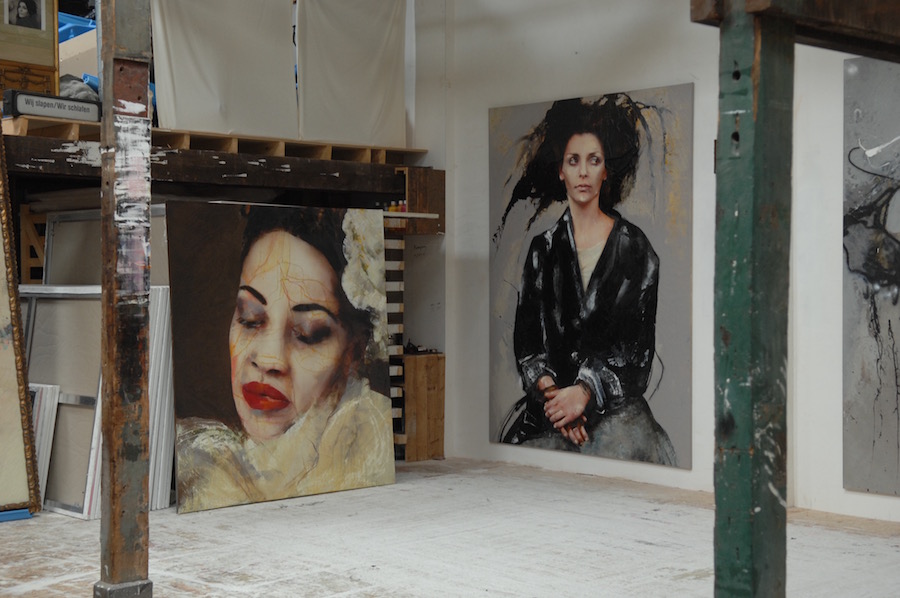
Lita Cabellut's studio. Photo: Elena Cué
Has art helped you forget or remember?
I’d say acknowledge. Provide a place. Listen, for example I painted monsters, images that were monstrous. I painted everything that frightened me and was still in my subconscious, and would suddenly appear like a capricious dog that sits in an unexpected spot. Feelings and images would come to me that I didn´t know what to do with. These days I don´t title my works, though I used to, because I wanted to identify them, I wanted to see all of those feelings. And it´s really interesting, because once you give those names and see them, they become very small. The more intelligent you are, the more fears you have. For children, who dream about that, it´s a kind of active intelligence. There is so much risk in the world, so many dangers, that intelligence needs to calculate those dangers in order to survive. It´s the law of the strong. I´ve always had many fears, like not being able to sleep with the lights off. Now I sleep with the lights off in the house, but not in the garden.
In other words, you’ve been getting rid of those demons through art, by giving them form and getting them out of your unconscious…
Exactly. I´ve been able to paint it all: ugliness, cruelty, tenderness, all of those elements… You have to think that you´re like an octopus, with tentacles that need to touch all kinds of emotions. If you are unlucky, some of those tentacles will be stunted, because they haven´t been able to recover or have not had the right space. I´ve been able to use them extensively in my own work. I´m certain that are has cured me. I have a foundation for children so there can be art. Because I´m absolutely sure that art goes much further than psychiatric methods. These are necessary as well, but art goes much further.
Art... and love?
I remember when I was small how difficult not feeling loved was. It was really tough. I’m a mother and I know what that is. No one can imagine how important the love of family is for so many things to grow. It´s true that tragedy, for artists, is like a box of jewels. You can´t paint suffering or pain if you haven´t lived it. It will always be an imitation, a caricature.
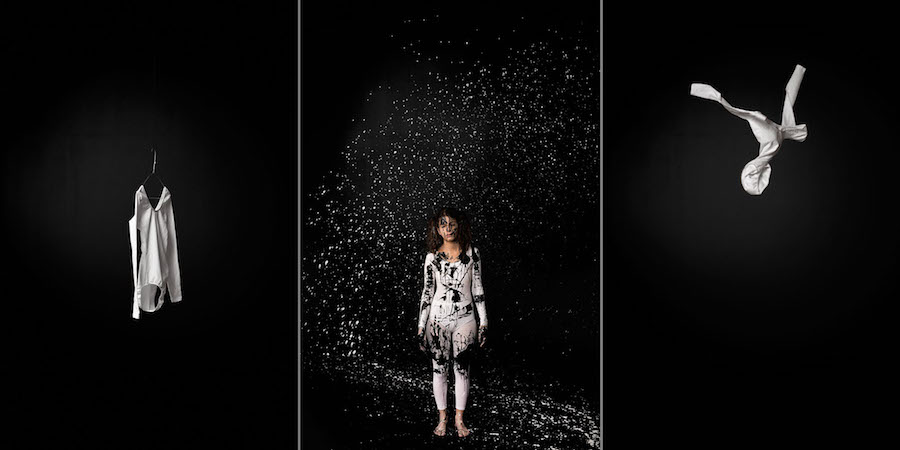
Lita Cabellut. Silence of the white. Courtesy of the artist's studio
Do your paintings tell your story?
In reality, they are all my stories. For example, Impulse is a series about the ultimatum of female beauty. You see how I threw puddles of paint on those paintings; they are really violent attacks. Impulse is always an act of violence, but an act of violence is also an act of love. I´ve lived a lot of violence, I´ve seen a lot of female violence. For me, it´s also a way of dealing with this topic, and of letting it go. It´s not that I am trying, through my work, to better the world, but that I simply try to show the world that these aspects must be considered, must be seen, named and above all given a voice.
Everything about you is learning and overcoming.
That is what I always try for. Elena, in everything that is ugly, you have to find that spot of beauty. Because it´s there, it´s always there, in the most horrible things that happen to you. I always say: if you haven’t walked on the carpet of sorrows, you can´t kiss life. It´s important, so you can know what you love and what you don´t. Imagine getting to the end of life, at an old age, and regretting everything we haven´t done, because we didn´t want to get into trouble, we didn’t want to commit or suffer too much. Can you imagine that?
Courage, that great virtue.
Courage is an act of responsibility. It´s so important, it allows you to change things, to move forward. What frightens us most is to be responsible for our actions. If you are brave, it means you accept that things can go wrong. Do you know how beautiful it is to accept that things might go bad? That´s freedom. Courage is freedom.
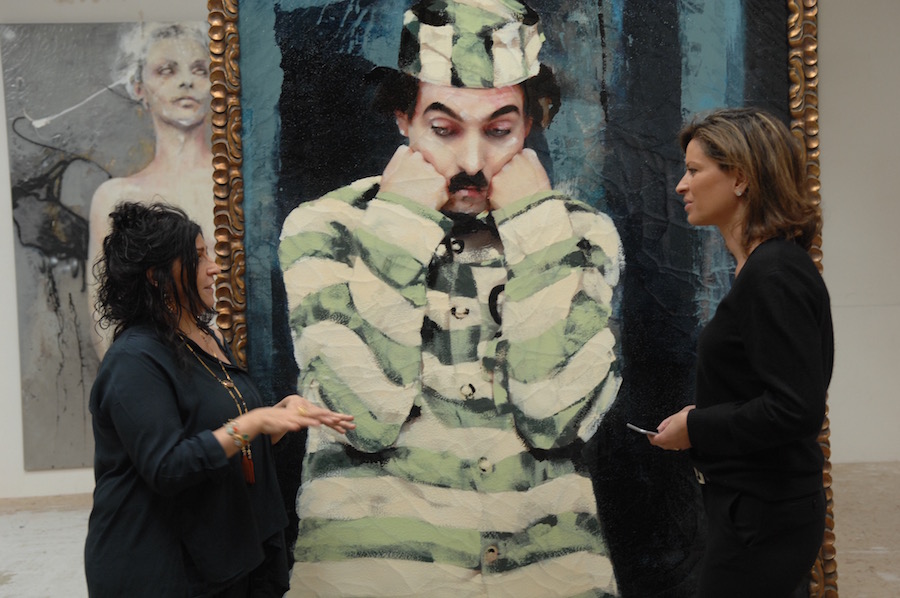
Lita Cabellut and Elena Cué during the interview. Photo: Elena Cué
- Interview with Lita Cabellut - - Página principal: Alejandra de Argos -



